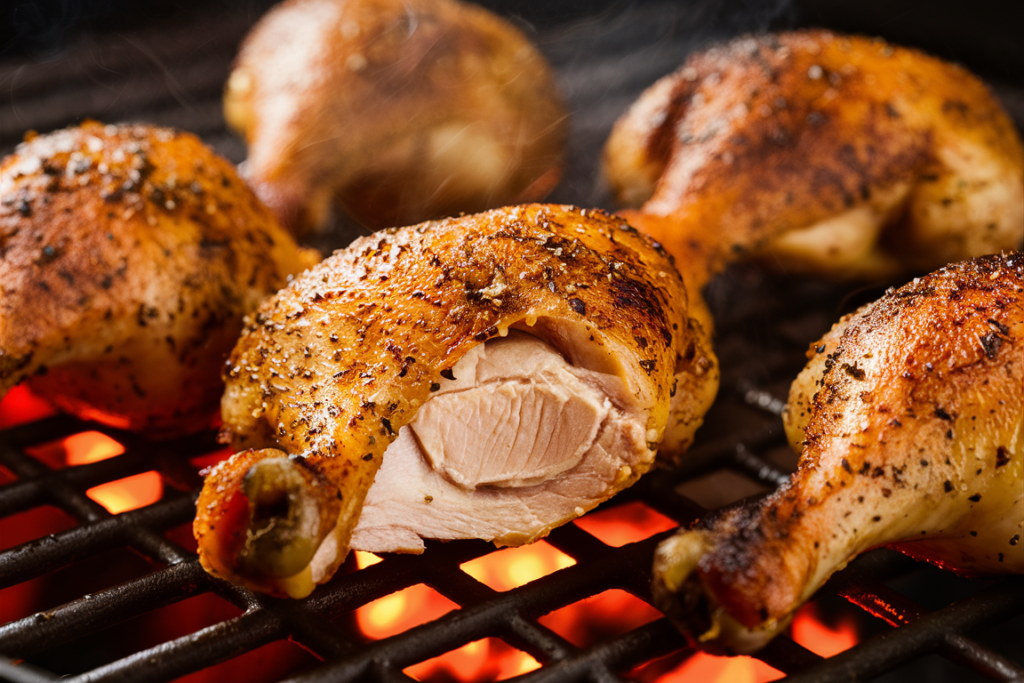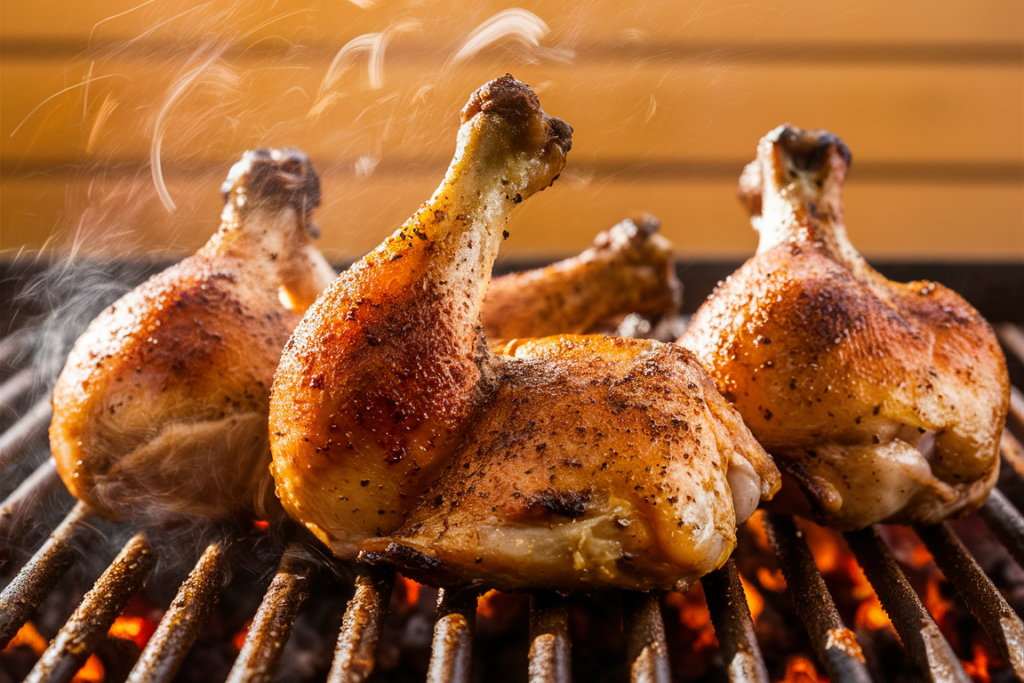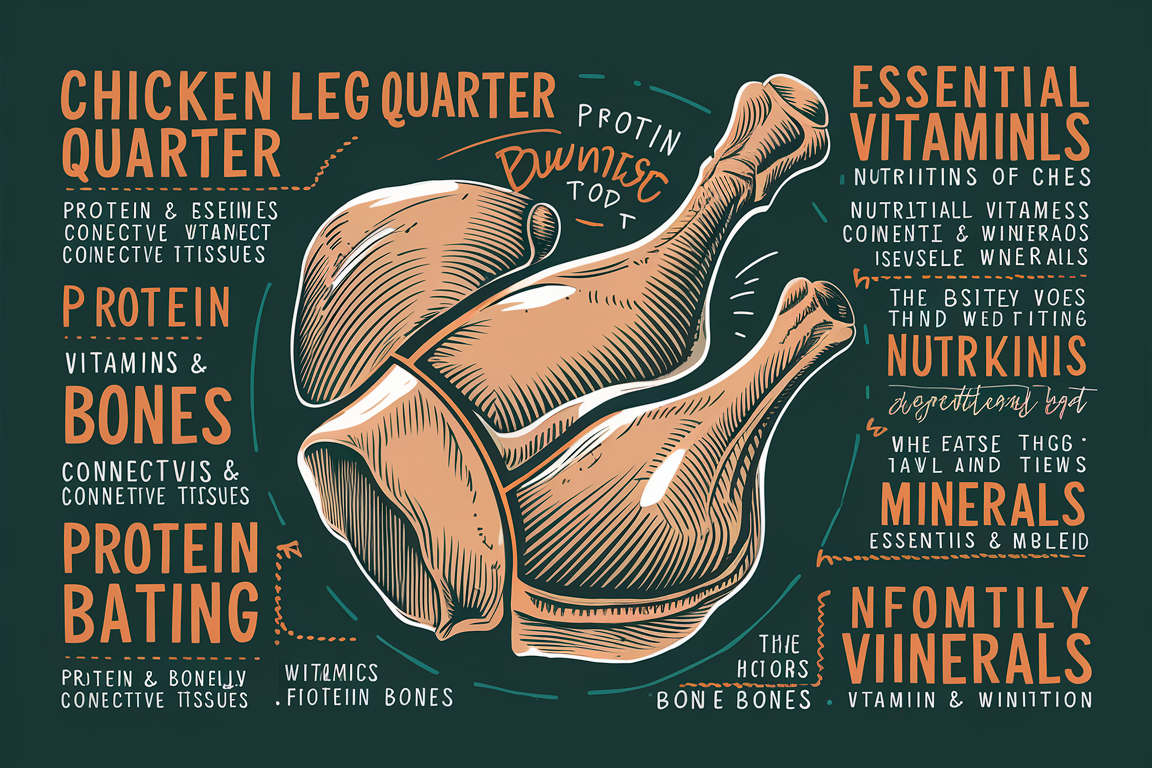Introduction
When it comes to chicken, the leg quarter is a widely loved and versatile choice. But what exactly does this cut include? From the tender drumstick and juicy thigh to the flavorful skin and bones, leg quarters have much to offer. This guide explores their anatomy, nutritional benefits, and cooking tips. Whether you’re a food enthusiast, health-conscious eater, or simply curious, you’re in for an informative journey!

Part 1: Introduction and Basics
What Are Chicken Leg Quarters Made Of?
Chicken leg quarters are aptly named because they make up a quarter of the chicken. This cut includes two main sections—the drumstick and the thigh—joined together, along with the skin and bones. Known for their affordability, rich taste, and versatility in the kitchen, they are a favorite for many dishes.
Leg quarters are a go-to for home cooks and chefs alike. The combination of dark meat and the skin makes them ideal for roasting, grilling, or frying. The bone-in structure also enhances the meat’s flavor and moisture, ensuring a mouthwatering meal.
What Part of the Chicken Is the Leg Quarter?
The chicken leg quarter comes from the lower half of the bird. Specifically, it includes:
- Drumstick: The lower leg portion, firm and flavorful, packed with muscle fibers.
- Thigh: Juicier and more tender, located above the drumstick.
- Skin: Often left intact, it crisps beautifully when cooked.
- Bones: Including the femur and part of the knee joint, which contribute to flavor during cooking.
These elements work together to create a cut that’s not only delicious but also a great source of essential nutrients like protein, zinc, and iron.
Understanding the Anatomy of Chicken Leg Quarters
The anatomy of a chicken leg quarter is fascinating! The drumstick is cylindrical, which makes it perfect for holding, and it’s primarily made of muscle. The thigh, on the other hand, has a higher fat content, making it richer in taste.
Between the drumstick and thigh lies a joint filled with connective tissue, which is softer when cooked slowly. The skin layer varies in thickness but plays a vital role in retaining moisture and adding crispness. Beneath the skin, there’s a balanced ratio of meat to fat, which ensures that every bite is succulent.
Part 2: Components and Anatomy of Chicken Leg Quarters
What Do Chicken Leg Quarters Consist Of?
Leg quarters consist of several key elements that combine to create their distinctive flavor and texture. These parts include:
- The Drumstick: This lower part of the leg is firmer due to its muscle fibers, which give it a distinct chewiness and intense flavor. Its unique cylindrical shape makes it convenient for grilling or handheld meals.
- The Thigh: Known for its tender, juicy texture, the thigh contains more fat than other parts of the chicken, making it rich in taste.
- Skin: When left on, the skin locks in moisture and crisps beautifully during cooking. It also contributes to the calorie count but offers a unique, savory crunch.
- Bones: The bones aren’t just structural—they infuse the meat with natural umami flavor during cooking, especially in methods like roasting or braising.
These components make the chicken leg quarter an economical, versatile, and tasty cut of meat that’s perfect for a wide variety of dishes.
Understanding the Anatomy of Chicken Leg Quarters
Exploring the structure of leg quarters sheds light on why they are such a favorite in cooking.
Drumstick Characteristics
The drumstick’s structure is mainly muscular. It has a high concentration of connective tissue, making it ideal for slow-cooked methods like braising or smoking. When cooked at high temperatures, such as grilling, the drumstick’s slightly chewy texture softens while its flavor intensifies.
Thigh Characteristics
The thigh is fattier and more tender, making it the star of dishes that require rich, juicy meat. Its slightly flat, oval shape allows for even cooking, and the fat melts into the meat during preparation, creating a succulent texture that’s hard to resist.
Skin and Bones
The skin plays a dual role: sealing in juices during cooking and providing a delightful crispiness. Bones, meanwhile, act as flavor conductors. They contain marrow, which adds depth and richness to broths or slow-cooked meals.
For additional insights into the nutritional profile of leg quarters, the USDA FoodData Central offers an in-depth breakdown.
Part 3: Nutritional Profile of Chicken Leg Quarters
Protein and Fat Content
Chicken leg quarters are a rich source of protein, essential for muscle repair and overall health. A typical skin-on, bone-in leg quarter contains approximately 25–30 grams of protein per serving, which contributes significantly to daily dietary needs.
However, the fat content can vary depending on how they’re prepared. The skin adds a layer of fat, which enhances flavor and moisture but also increases the calorie count. Removing the skin can reduce the fat content significantly, making the dish leaner and healthier for those monitoring their intake.
Why the Skin Matters
The skin-on variety boasts a satisfying crispiness when cooked properly, making it a favorite for roasting or grilling. While it contains fats, it’s predominantly unsaturated, which, in moderation, can support heart health.
Vitamins and Minerals in Chicken Leg Quarters
Chicken leg quarters aren’t just about protein—they’re packed with essential vitamins and minerals too:
- Iron: Supports healthy blood cells and combats fatigue.
- Zinc: Boosts immune function and aids in cell repair.
- Vitamin B6: Plays a role in brain health and energy production.
- Phosphorus: Vital for strong bones and teeth.
Eating dark meat, like thighs and drumsticks, provides more iron and zinc than white meat. These nutrients are particularly beneficial for individuals with higher nutritional needs, such as athletes or those recovering from illnesses.
Calories in Chicken Leg Quarters
The caloric value of chicken leg quarters varies depending on cooking methods and whether the skin is left on. On average:
- Skin-On, Bone-In: Roughly 250–300 calories per serving.
- Skinless: Around 180–220 calories per serving.
Grilling or baking allows fat to render off, reducing calorie content while keeping the meat flavorful. To explore healthier ways to prepare chicken leg quarters, visit Mayo Clinic’s Nutrition Tips.
Part 4: Comparisons and Culinary Uses
How Chicken Leg Quarters Compare to Other Cuts
Leg Quarters vs. Chicken Breasts
When it comes to chicken cuts, leg quarters and breasts are often compared due to their differences in flavor, texture, and nutritional profiles:
- Flavor: Leg quarters are known for their rich, juicy taste due to their higher fat content. Chicken breasts, by contrast, are leaner but can be less flavorful without seasoning or sauces.
- Texture: Dark meat from leg quarters is more tender and forgiving during cooking, whereas chicken breasts can become dry if overcooked.
- Nutrition: While chicken breasts are lower in calories and fat, leg quarters provide more iron, zinc, and B vitamins.
For those seeking flavor-packed meals, leg quarters are a clear winner. However, for health-conscious individuals on calorie-restricted diets, chicken breasts might be a better fit.
Leg Quarters vs. Drumsticks and Thighs
When broken down, the drumstick and thigh offer distinct culinary advantages:
- Drumsticks: Easier to handle and great for grilling or fried chicken. Their cylindrical shape makes them ideal for handheld eating.
- Thighs: With their slightly higher fat content, thighs are more tender and lend themselves well to slow-cooked dishes like stews or curries.
While cooking whole leg quarters, the synergy of drumstick and thigh together delivers the best of both worlds—a balance of chewiness and tenderness.
Popular Cooking Methods for Chicken Leg Quarters
Oven-Baked, Grilled, and Fried Options
Chicken leg quarters are incredibly versatile, lending themselves to a variety of cooking methods:
- Baking: Oven-baked leg quarters are a crowd-pleaser. The skin crisps beautifully while the meat stays juicy inside. Use a mix of spices like paprika, garlic powder, and thyme for a golden-brown finish.
- Grilling: A grill imparts smoky flavors while ensuring the fat renders off. Perfect for summer barbecues!
- Frying: For a crispy, indulgent treat, fried leg quarters are a favorite, though they do increase the calorie count significantly.
Seasoning and Marinade Ideas
Enhance the flavor of chicken leg quarters with marinades or spice rubs. Here are a few popular options:
- Herb and Garlic: Combine olive oil, garlic, rosemary, and lemon juice for a simple yet aromatic seasoning.
- Spicy Rub: Use cayenne, paprika, cumin, and black pepper for a bold kick.
- Sweet and Tangy: Mix honey, soy sauce, and a dash of vinegar for a sticky glaze.
These methods and marinades elevate the humble chicken leg quarter to a gourmet experience. Check out BBC Good Food’s Recipes for inspiration on preparing these dishes.
Part 5: Flavor and Texture Insights
The Unique Flavor Profile of Chicken Leg Quarters
Why Leg Quarters Are Juicier Than Other Cuts
When it comes to flavor, chicken leg quarters are in a league of their own. Thanks to their dark meat composition, they naturally contain more fat, which melts into the meat during cooking, creating an irresistibly juicy bite. Unlike chicken breasts, which can dry out quickly, leg quarters remain tender and moist, even with high-heat cooking methods like grilling or roasting.
The richness of leg quarters makes them ideal for bold seasonings and marinades. Whether coated with aromatic herbs or spiced up with smoky rubs, their flavor effortlessly stands out, offering a deeply satisfying experience for the palate.
Texture Differences: Bone-In vs. Boneless Leg Quarters
The presence of the bone in leg quarters does more than just add structure—it significantly enhances the texture and taste. Bones contain marrow, which releases subtle, savory flavors when heated, infusing the meat with depth. Additionally, the bone helps regulate cooking temperature, ensuring the meat cooks evenly without drying out.
On the other hand, boneless leg quarters, though convenient, lose some of this natural flavor enhancement. However, they are easier to eat and work well in stir-fries, casseroles, and other quick meals.
Texture and Cooking Tips for Maximum Juiciness
Achieving the perfect texture involves understanding how to cook leg quarters properly:
- Slow Cooking: For fall-off-the-bone tenderness, slow-cooked leg quarters are a game-changer. Methods like braising keep the meat moist while intensifying flavors.
- Crisping the Skin: For skin-on quarters, pat the skin dry and brush it with oil before cooking. This ensures a crispy, golden crust.
- High-Heat Roasting: Roasting at 425°F locks in juices and caramelizes the exterior, giving you a combination of crispy skin and tender meat.
The blend of juicy meat and crisp skin makes chicken leg quarters a culinary favorite across various cuisines.
Part 6: Health Insights and FAQs
Health Benefits and Considerations
Nutritional Advantages of Chicken Leg Quarters
Chicken leg quarters offer an impressive range of nutrients that make them a valuable addition to a balanced diet. They’re a fantastic source of:
- Protein: Essential for building and repairing muscle tissue, leg quarters provide a hearty dose of high-quality protein.
- Iron and Zinc: Dark meat like that found in leg quarters is packed with these essential minerals, which support immune health and energy levels.
- B Vitamins: Including B6 and niacin, which aid in energy metabolism and brain function.
Beyond their nutritional profile, the affordability and versatility of chicken leg quarters make them a go-to protein source for families and meal preppers.
Potential Health Concerns
While leg quarters have many health benefits, there are a few considerations to keep in mind:
- Cholesterol and Saturated Fats: The fat content, particularly in the skin, can contribute to higher cholesterol levels. However, removing the skin can mitigate this issue.
- Portion Size: Due to their rich flavor and calorie density, it’s easy to overconsume. Balance your plate with plenty of vegetables and whole grains for a well-rounded meal.
Healthy preparation methods like grilling, baking, or slow cooking can further enhance their nutritional value while reducing added fats.
Frequently Asked Questions (FAQ)
What Are Chicken Leg Quarters?
Chicken leg quarters consist of the drumstick, thigh, and a portion of the back. They’re a complete quarter of the chicken, offering a balanced ratio of meat, fat, and bone.
How Many Calories Are in a Chicken Leg Quarter?
A typical leg quarter contains about 250–300 calories if cooked with the skin, or 180–220 calories if skinless. The calorie count may vary based on cooking methods and seasoning.
Are Chicken Leg Quarters Healthy?
Yes! They are nutrient-dense and rich in protein, vitamins, and minerals. Opt for skinless or grilled versions to maximize health benefits.
Can You Cook Chicken Leg Quarters in an Air Fryer?
Absolutely! Air frying is a fantastic way to achieve crispy skin with minimal added fat. It’s a quick and healthy cooking method for this cut.
What’s the Best Seasoning for Chicken Leg Quarters?
The best seasoning depends on your taste preferences. Popular choices include garlic and herb rubs, spicy marinades, or sweet and tangy glazes.
Part 7: Conclusion and Related Recipes
Summary of What Chicken Leg Quarters Are Made Of
Chicken leg quarters are a versatile, flavorful, and nutrient-packed cut of poultry. Comprised of the drumstick, thigh, skin, and bones, they offer a perfect balance of tenderness and juiciness. Their dark meat composition makes them richer in iron, zinc, and B vitamins compared to other chicken cuts, while their affordability and ease of cooking make them a favorite in kitchens worldwide. Whether roasted, grilled, or slow-cooked, leg quarters shine in countless dishes, proving their worth as a staple ingredient for home cooks and food enthusiasts alike.
Popular Chicken Leg Quarter Recipes to Try
Ready to put those chicken leg quarters to good use? Here are some recipe ideas that showcase their versatility and flavor:
- Herb-Roasted Chicken Leg Quarters: Coat the quarters with olive oil, minced garlic, rosemary, and thyme. Roast at 425°F until golden and crispy. Serve with roasted vegetables for a wholesome meal.
- BBQ Grilled Chicken Leg Quarters: Marinate in your favorite barbecue sauce and grill to perfection, turning occasionally to get that smoky char.
- Slow-Cooked Chicken Leg Quarters with Vegetables: Place the leg quarters in a slow cooker with carrots, potatoes, onions, and a mix of chicken broth and spices. Cook on low for 6–8 hours for tender, fall-off-the-bone meat.
For more inspiration and step-by-step guides, check out these resources:
This concludes the comprehensive guide on what chicken leg quarters are made of. Dive into the culinary possibilities, experiment with flavors, and enjoy this versatile cut in your next meal!


